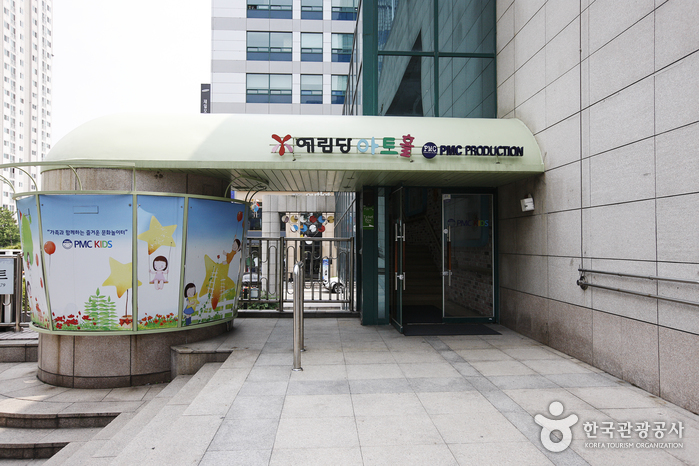Davich Optical - Bangbae Branch [Tax Refund Shop] (다비치안경 방배)
9.9Km 2024-04-23
4, Bangbae-ro 20-gil, Seocho-gu, Seoul
-
Olive Young - Teheranro Branch [Tax Refund Shop] (올리브영 테헤란로점)
10.0Km 2024-06-26
1F, 514, Teheran-ro, Gangnam-gu, Seoul
-
GS25 - Gangnam Juvis Branch [Tax Refund Shop] (GS25강남쥬비스점)
10.0Km 2024-06-26
1F, 434, Samseong-ro, Gangnam-gu, Seoul
-
Yearimdang Art Hall (예림당아트홀)
10.0Km 2021-12-07
337, Eonju-ro, Gangnam-gu, Seoul
+82-2-6413-3689
Yearimdang Art Hall is a children’s theater that opened in March 2011. A joint project of Yearimdang publishing company and PMC Production, the art hall is a mid-sized theater with 439 seats divided into two floors. The first floor consists of VIP sets and S-class seats that allow for more interaction with the actors on stage and access to surprise events during the performances. Seats on the second floor (A-class) offer an affordable, bird’s-eye-view of the stage. The seats are designed to fit children’s body, while providing parents with much needed rest.
Olive Young - Gangnam Woosung Branch [Tax Refund Shop] (올리브영 강남우성점)
10.0Km 2024-06-27
1F, 320, Gangnam-daero, Gangnam-gu
-
Circletour Co., Ltd. (주식회사 써클투어)
10.0Km 2025-10-23
(#1411, Hwanghwa Building), 320 Gangnam-daero, Gangnam-gu, Seoul
CIRCLETOUR was established in 2007, we aim to be a trustworthy and preferred travel agency. We operates on the principle of providing 'One & Only' services, offering safe medical tourism tailored to customer needs and trends for specially women and kids. We have experiences and expertise in customized premium medical tour.
Seoul Hiking Tourism Center - Bukhansan Branch (서울도심등산관광센터(북한산))
10.0Km 2024-03-05
5F, 181-7 Ui-dong, Gangbuk-gu, Seoul
+82-1533-2608
The Seoul Hiking Tourism Center is located 5 minutes on foot from Exit 2 of Bukhansan Ui Station and provides various services to hikers. It provides hiking course guidance and information (available in Korean, English, Chinese, and Japanese) about the mountains of Seoul, including Bukhansan, Bugaksan, and Inwangsan Mountains, as well as promotional materials such as Seoul hiking tourism guidebooks and maps. Also, it operates hiking tour programs with various themes every week for foreigners and offers hiking gear rental services such as hiking boots, hiking attire, trekking poles, gloves, and crampons for foreigners. (Koreans accompanied by foreigners can also rent the gear.) In addition, there is a storage locker and lounge for visitors, so they can pack up and rest before hiking.
The Oreum (디오름)
10.0Km 2024-02-21
136-10 Yongdu-ro 47beon-gil, Deogyang-gu, Goyang-si, Gyeonggi-do
The Oreum presents various spatial concepts on each floor, ranging from reed-themed to black or white-themed spaces. The café boasts dedicated sections for media art enthusiasts and a rooftop area ideal for photography sessions. Their standout offerings include the Truffle spänner, a delightful blend of creamy sweetness infused with truffle essence, and the Jeju matcha crumble, featuring smooth cream and savory crumbles. The aromatic americano crafted from Geisha coffee beans is also one of the patrons' favorites.
Homeplus - Yeongdeungpo Branch [Tax Refund Shop] (홈플러스 영등포)
10.1Km 2024-04-22
42, Dangsan-ro, Yeongdeungpo-gu, Seoul
-
Olive Young - Homeplus Yeongdeungpo Branch [Tax Refund Shop] (올리브영 홈플러스영등포)
10.1Km 2024-04-23
42, Dangsan-ro, Yeongdeungpo-gu, Seoul
-
![Davich Optical - Bangbae Branch [Tax Refund Shop] (다비치안경 방배)](http://tong.visitkorea.or.kr/cms/resource/24/2889024_image2_1.jpg)


 English
English
 한국어
한국어 日本語
日本語 中文(简体)
中文(简体) Deutsch
Deutsch Français
Français Español
Español Русский
Русский